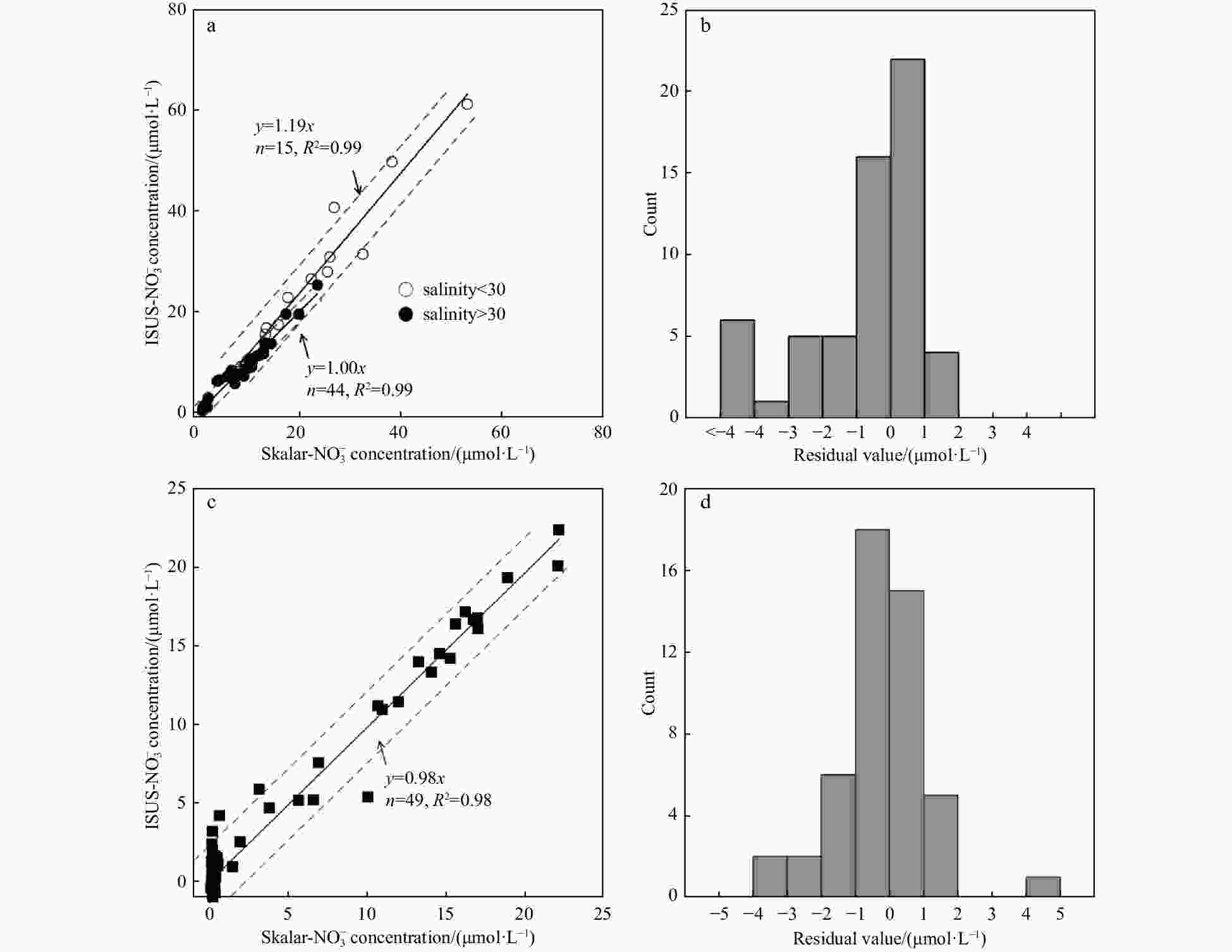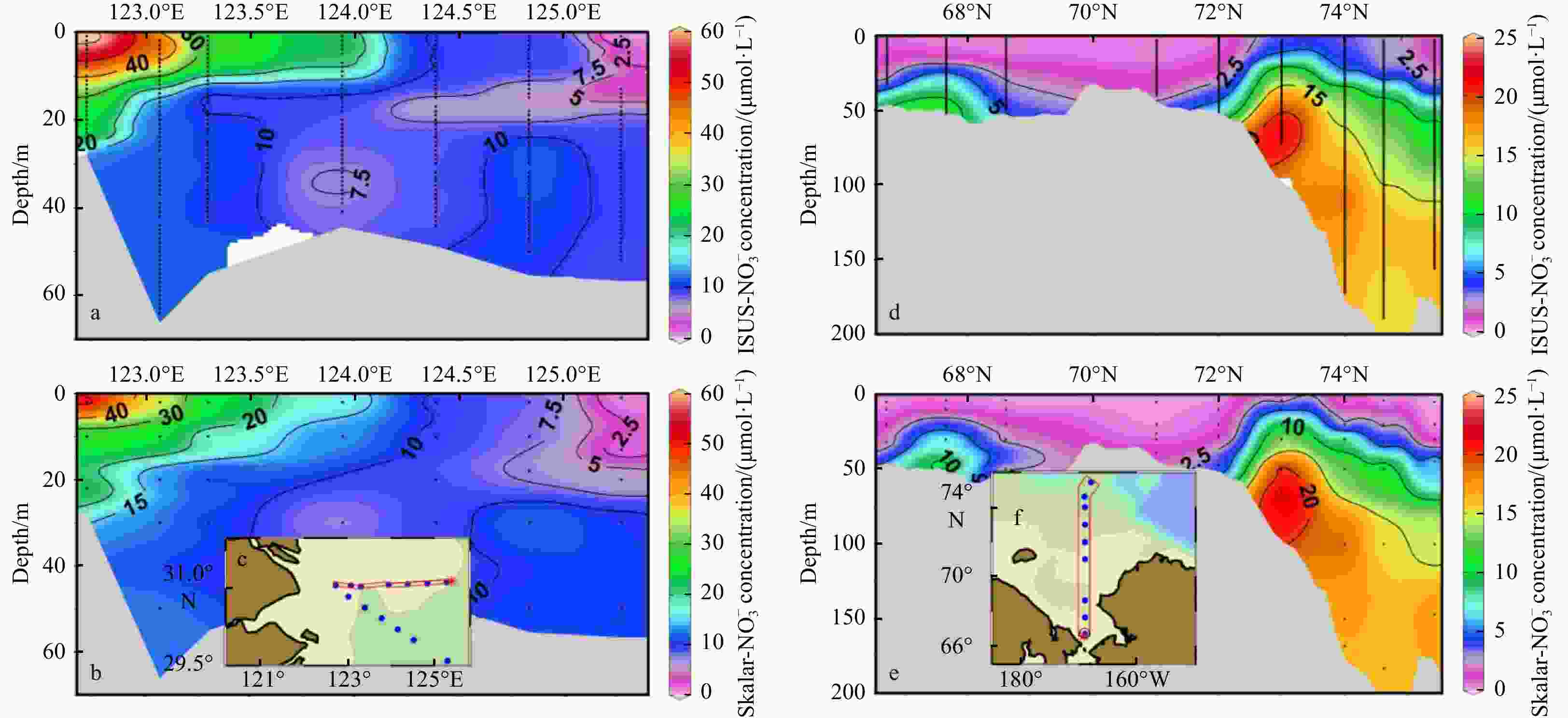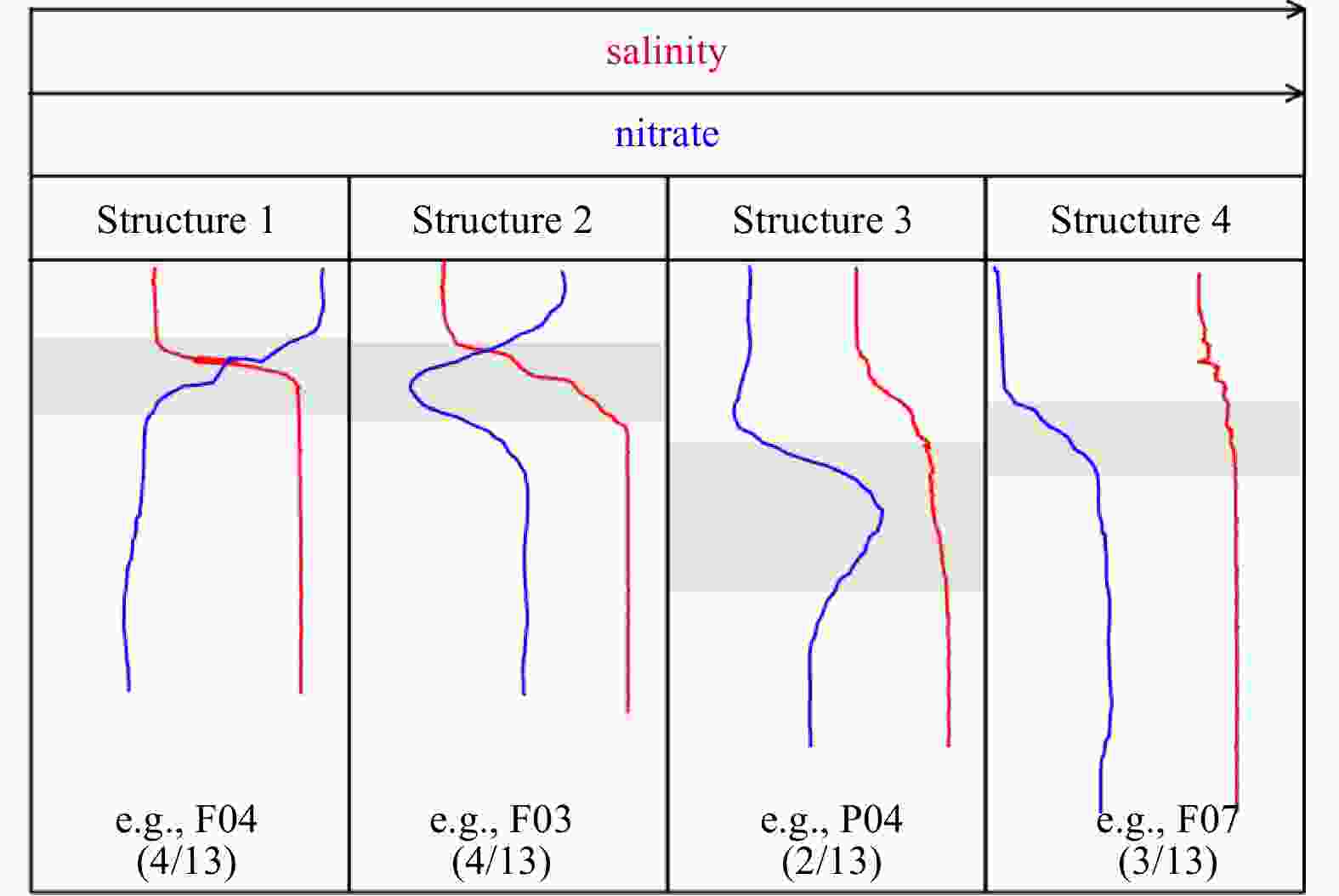Application of an optical nitrate profiler to high- and low-turbidity coastal shelf waters
-
Abstract: Here, we report the results of high-resolution nitrate measurements using an optical nitrate profiler (in situ ultraviolet spectrophotometer, ISUS) along transect across a high-turbidity shelf (East China Sea) and a low-turbidity shelf (Chukchi Sea). The ISUS-measured nitrate concentrations closely reproduced the results measured by conventional bottle methods in low-turbidity waters. However, for high-turbidity waters of the East China Sea (salinity<30), a correction factor of 1.19 was required to match the standard bottle measurements. The high-resolution ISUS data revealed subtle spatial variability (e.g., a subsurface nitrate minimum) that may have been missed if based solely on bottle results. Four main structures of the nitracline on the East China Sea are apparent from the ISUS nitrate profile. High-resolution nitrate data are important for studying nitrate budgets and nutrient dynamics on continental shelves.
-
Figure 2. Capability of in situ ultraviolet spectrophotometer (ISUS) on a high-turbidity shelf (East China Sea) and a low-turbidity shelf (Chukchi Sea). Relationship between the two datasets (a) and histogram of the residual (b) between ISUS-
${{\rm {NO}}_3^-} $ and Skalar-${{\rm {NO}}_3^-} $ on the East China Sea during summer 2011. The c and d demonstrate similar relationship with a and b, but for the Chukchi Sea during summer 2014. The solid and dashed lines in a and c are linear regression lines and one standard deviation, respectively.Figure 3. Distributions of nitrate obtained by high-resolution measurements (ISUS-
${{\rm {NO}}_3^-} $ ) and conventional techniques (Skalar-${{\rm {NO}}_3^-} $ ) on the East China Sea and Chukchi Sea. ISUS-${{\rm {NO}}_3^-} $ (a) and Skalar-${{\rm {NO}}_3^-} $ (b) data across the East China Sea, and location of the sampling transect (c). d−f demonstrate similar relationship with a−c, but for the Chukchi Sea shelf. Note that the data of ISUS-${{\rm {NO}}_3^-} $ are the original values.Figure 4. Characteristics of the nitracline on the high-turbidity East China Sea, which is influenced by the Changjiang River. Red and blue lines represent salinity and nitrate concentration, respectively. The nitracline had four main structures (Structures 1−4). The figures in parentheses are the number of sampling sites where each structure was observed. Sites F04, F03, P04 and F07 refer to Fig. 1.
-
Bauer J E, Cai Weijun, Raymond P A, et al. 2013. The changing carbon cycle of the coastal ocean. Nature, 504(7478): 61–70. doi: 10.1038/nature12857 Chen Fajin, Chen Jianfang, Jia Guodong, et al. 2013. Nitrate δ15N and δ18O evidence for active biological transformation in the Changjiang Estuary and the adjacent East China Sea. Acta Oceanologica Sinica, 32(4): 11–17. doi: 10.1007/s13131-013-0294-4 Chen Chen-Tung Arthur, Wang Shulun. 1999. Carbon, alkalinity and nutrient budgets on the East China Sea continental shelf. Journal of Geophysical Research: Oceans, 104(C9): 20675–20686. doi: 10.1029/1999JC900055 Chen Fajin, Zhou Xin, Lao Qibin, et al. 2019. Dual isotopic evidence for nitrate sources and active biological transformation in the northern South China Sea in summer. PLoS ONE, 14(1): e0209287. doi: 10.1371/journal.pone.0209287 Cloern J E. 2001. Our evolving conceptual model of the coastal eutrophication problem. Marine Ecology Progress Series, 210: 223–253. doi: 10.3354/meps210223 Finch M S, Hydes D J, Clayson C H, et al. 1998. A low power ultra violet spectrophotometer for measurement of nitrate in seawater: introduction, calibration and initial sea trials. Analytica Chimica Acta, 377(2–3): 167–177 Grasshoff K, Kremling K, Ehrhardt M. 2009. Methods of Seawater Analysis. New York: John Wiley & Sons Guo Weidong, Stedmon C A, Han Yuchao, et al. 2007. The conservative and non-conservative behavior of chromophoric dissolved organic matter in Chinese estuarine waters. Marine Chemistry, 107(3): 357–366. doi: 10.1016/j.marchem.2007.03.006 Guo Weidong, Yang Liyang, Zhai Weidong, et al. 2014. Runoff-mediated seasonal oscillation in the dynamics of dissolved organic matter in different branches of a large bifurcated estuary—The Changjiang Estuary. Journal of Geophysical Research: Biogeosciences, 119(5): 776–793. doi: 10.1002/2013JG002540 Johnson K S. 2010. Simultaneous measurements of nitrate, oxygen, and carbon dioxide on oceanographic moorings: Observing the Redfield ratio in real time. Limnology and Oceanography, 55(2): 615–627. doi: 10.4319/lo.2010.55.2.0615 Johnson K S, Barry J P, Coletti L J, et al. 2011. Nitrate and oxygen flux across the sediment-water interface observed by eddy correlation measurements on the open continental shelf. Limnology and Oceanography: Methods, 9(11): 543–553. doi: 10.4319/lom.2011.9.543 Johnson K S, Coletti L J. 2002. In situ ultraviolet spectrophotometry for high resolution and long-term monitoring of nitrate, bromide and bisulfide in the ocean. Deep-Sea Research Part I: Oceanographic Research Papers, 49(7): 1291–1305. doi: 10.1016/S0967-0637(02)00020-1 Johnson K S, Coletti L J, Chavez F P. 2006. Diel nitrate cycles observed with in situ sensors predict monthly and annual new production. Deep-Sea Research Part I: Oceanographic Research Papers, 53(3): 561–573. doi: 10.1016/j.dsr.2005.12.004 Johnson K S, Coletti L J, Jannasch H W, et al. 2013. Long-term nitrate measurements in the ocean using the in situ ultraviolet spectrophotometer: sensor integration into the APEX profiling float. Journal of Atmospheric & Oceanic Technology, 30(8): 1854–1866 Johnson K S, Needoba J A. 2008. Mapping the spatial variability of plankton metabolism using nitrate and oxygen sensors on an autonomous underwater vehicle. Limnology and Oceanography, 53: 2237–2250. doi: 10.4319/lo.2008.53.5_part_2.2237 Johnson K S, Plant J N, Dunne J P, et al. 2017. Annual nitrate drawdown observed by SOCCOM profiling floats and the relationship to annual net community production. Journal of Geophysical Research: Oceans, 122(8): 6668–6683. doi: 10.1002/2017JC012839 Johnson K S, Riser S C, Karl D M. 2010. Nitrate supply from deep to near-surface waters of the North Pacific subtropical gyre. Nature, 465(7301): 1062–1065. doi: 10.1038/nature09170 Kaplunenko D D, Lobanov V B, Tishchenko P Y, et al. 2013. Nitrate in situ measurements in the northern Japan Sea. Deep-Sea Research Part II: Topical Studies in Oceanography, 86–87: 10–18 Khandelwal A, González-Pinzón R, Regier P, et al. 2020. Introducing the self-cleaning filtration for water quality sensors (SC-FLAWLeSS) system. Limnology and Oceanography: Methods, 18(9): 467–476. doi: 10.1002/lom3.10377 Li Yangjie, Jin Haiyan, Chen Jianfang, et al. 2021. Nitrogen removal through sediment denitrification in the Yangtze Estuary and its adjacent East China Sea: A nitrate limited process during summertime. Science of the Total Environment, 795: 148616. doi: 10.1016/j.scitotenv.2021.148616 Liu Sumei, Qi Xiaohong, Li Xiaona, et al. 2016. Nutrient dynamics from the Changjiang (Yangtze River) Estuary to the East China Sea. Journal of Marine Systems, 154: 15–27. doi: 10.1016/j.jmarsys.2015.05.010 Liu J P, Xu K H, Li A C, et al. 2007. Flux and fate of Yangtze River sediment delivered to the East China Sea. Geomorphology, 85(3–4): 208–224 MacIntyre G, Plache B, Lewis M R, et al. 2009. ISUS/SUNA nitrate measurements in networked ocean observing systems. In: OCEANS 2009. Biloxi, MS, USA: IEEE, 1–7 Mao Zhihua, Chen Jianyu, Pan Delu, et al. 2012. A regional remote sensing algorithm for total suspended matter in the East China Sea. Remote Sensing of Environment, 124: 819–831. doi: 10.1016/j.rse.2012.06.014 Meyer D, Prien R D, Rautmann L, et al. 2018. In situ determination of nitrate and hydrogen sulfide in the Baltic Sea using an ultraviolet spectrophotometer. Frontiers in Marine Science, 5: 431. doi: 10.3389/fmars.2018.00431 Pellerin B A, Bergamaschi B A, Gilliom R J, et al. 2014. Mississippi River nitrate loads from high frequency sensor measurements and regression-based load estimation. Environmental Science & Technology, 48(21): 12612–12619 Pidcock R, Srokosz M, Allen J, et al. 2010. A novel integration of an ultraviolet nitrate sensor on board a towed vehicle for mapping open-ocean submesoscale nitrate variability. Journal of Atmospheric & Oceanic Technology, 27(8): 1410–1416 Prien R D. 2007. The future of chemical in situ sensors. Marine Chemistry, 107(3): 422–432. doi: 10.1016/j.marchem.2007.01.014 Randelhoff A, Guthrie J D. 2016. Regional patterns in current and future export production in the central Arctic Ocean quantified from nitrate fluxes. Geophysical Research Letters, 43(16): 8600–8608. doi: 10.1002/2016GL070252 Rönnberg C, Bonsdorff E. 2004. Baltic Sea eutrophication: area-specific ecological consequences. Hydrobiologia, 514(1–3): 227–241 Sakamoto C M, Johnson K S, Coletti L J. 2009. Improved algorithm for the computation of nitrate concentrations in seawater using an in situ ultraviolet spectrophotometer. Limnology and Oceanography: Methods, 7(1): 132–143. doi: 10.4319/lom.2009.7.132 Sakamoto C M, Johnson K S, Coletti L J, et al. 2017. Pressure correction for the computation of nitrate concentrations in seawater using an in situ ultraviolet spectrophotometer. Limnology and Oceanography: Methods, 15(10): 897–902. doi: 10.1002/lom3.10209 Schlitzer R. 2018. Ocean Data View. http://odv.awi.de[2018-04-04/2019-12-03] Wang Bin, Chen Jianfang, Jin Haiyan, et al. 2017. Diatom bloom-derived bottom water hypoxia off the Changjiang Estuary, with and without typhoon influence. Limnology and Oceanography, 62(4): 1552–1569. doi: 10.1002/lno.10517 Wang Baodong, Wang Xiulin, Zhan Run. 2003. Nutrient conditions in the Yellow Sea and the East China Sea. Estuarine, Coastal and Shelf Science, 58(1): 127–136 Wang Baodong, Wei Qinsheng, Chen Jianfang, et al. 2012. Annual cycle of hypoxia off the Changjiang (Yangtze River) Estuary. Marine Environmental Research, 77: 1–5. doi: 10.1016/j.marenvres.2011.12.007 Yan Weijin, Zhang Shen, Sun Pu, et al. 2003. How do nitrogen inputs to the Changjiang basin impact the Changjiang River nitrate: A temporal analysis for 1968–1997. Global Biogeochemical Cycles, 17(4): 1091. doi: 10.1029/2002GB002029 Zhai Weidong, Dai Minhan. 2009. On the seasonal variation of air-sea CO2 fluxes in the outer Changjiang (Yangtze River) Estuary, East China Sea. Marine Chemistry, 117(1–4): 2–10 Zhang Jing, Liu Sumei, Ren Jingling, et al. 2007. Nutrient gradients from the eutrophic Changjiang (Yangtze River) Estuary to the oligotrophic Kuroshio waters and re-evaluation of budgets for the East China Sea Shelf. Progress in Oceanography, 74(4): 449–478. doi: 10.1016/j.pocean.2007.04.019 Zhou Feng, Xue Huijie, Huang Daji, et al. 2015. Cross-shelf exchange in the shelf of the East China Sea. Journal of Geophysical Research: Oceans, 120(3): 1545–1572. doi: 10.1002/2014JC010567 Zhuang Yanpei, Jin Haiyan, Cai Weijun, et al. 2021a. Freshening leads to a three-decade trend of declining nutrients in the western Arctic Ocean. Environmental Research Letters, 16(5): 054047. doi: 10.1088/1748-9326/abf58b Zhuang Yanpei, Jin Haiyan, Chen Jianfang, et al. 2020. Phytoplankton community structure at subsurface chlorophyll maxima on the western Arctic shelf: patterns, causes, and ecological importance. Journal of Geophysical Research: Biogeosciences, 125(6): e2019JG005570. doi: 10.1029/2019JG0005570 Zhuang Yanpei, Jin Haiyan, Gu Fan, et al. 2017. Composition of algal pigments in surface freshen layer after ice melt in the central Arctic. Acta Oceanologica Sinica, 36(8): 122–130. doi: 10.1007/s13131-017-1024-0 Zhuang Yanpei, Jin Haiyan, Li Hongliang, et al. 2016. Pacific inflow control on phytoplankton community in the Eastern Chukchi Shelf during summer. Continental Shelf Research, 129: 23–32. doi: 10.1016/j.csr.2016.09.010 Zhuang Yanpei, Jin Haiyan, Zhang Yang, et al. 2021b. Incursion of Alaska Coastal Water as a mechanism promoting small phytoplankton in the western Arctic Ocean. Progress in Oceanography, 197: 102639. doi: 10.1016/j.pocean.2021.102639 -
 Zhuang Yanpei Supplentary material quan.docx
Zhuang Yanpei Supplentary material quan.docx

-





 下载:
下载:













